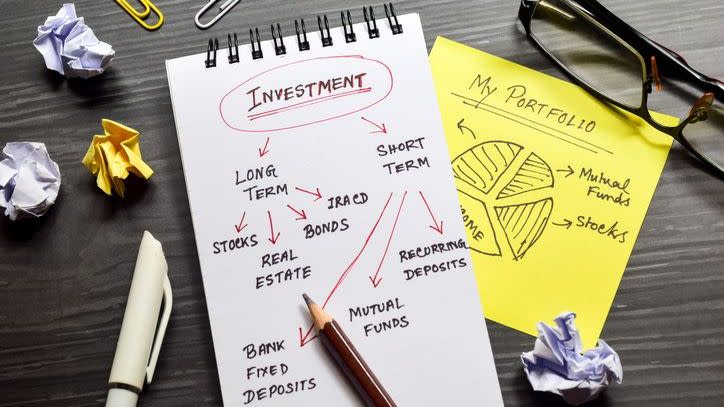Your financial goals and risk tolerance primarily determine how you structure your portfolio. But you should also consider taxes and fees, your potential life expectancy, the need for long-term care, and your desire to leave an inheritance.
A financial advisor can help you find the right portfolio construction strategy for your situation. Contact a fiduciary advisor today.
Many people approaching retirement use a bucket structure to fund their short-, medium-, and long-term goals with a mix of cash, stocks, and bonds. You can also choose between traditional asset allocation, core and satellite, and other approaches.
Portfolio structure considerations
Let’s say you’re 65 years old, have a portfolio of $1.1 million, and plan to retire soon. To figure out how to structure your portfolio, you should first consider three key issues:
-
Goals: Think about your short- and long-term goals. What type of retirement lifestyle do you envision? How much income do you need from your portfolio and other income sources to pay for it? Do you want to leave a financial legacy?
-
risk: Ask yourself how well you can handle fluctuations in the returns on your investments. Can you resist the impulse to sell when the market collapses? Do you want to increase withdrawals during a boom?
-
Cost: Thinking about ways to reduce taxes and fees can help your investments reach their full potential. For example, you can minimize taxes and fees by building core holdings of low-cost, passively managed index funds.
If you need help assessing your financial goals and risk tolerance, or finding ways to reduce taxes and fees, consider working with a financial advisor.
Common portfolio structures


You can choose from various standard portfolio structures. Some, such as Core and Satellite, Dynamic Asset Allocation and Life Cycle, may be well-suited to savers who are early in their careers and still have decades to go before retirement.
For people nearing retirement, a bucket strategy combined with traditional asset allocation is a popular choice. This approach typically divides your portfolio into three areas. Each bucket contains assets that are appropriately invested for short-, medium-, and long-term retirement goals.
-
Short term bucket: This category is designed to work with other sources of fixed income, such as Social Security and pensions, to cover your expenses for the first two years of your retirement. It is typically invested in insured savings accounts or other safe, liquid options. This approach helps you manage your bills without being affected by market fluctuations.
-
Medium term bucket: This bucket contains investments that you plan to liquidate and convert to cash within three to ten years. Assets in this area may include longer-term bonds, preferred stocks, growth and income funds, and other fixed income investments. The income from this investment pool can be used to replenish the short-term amount as soon as it is drawn down.
-
Long term bucket: This part of your portfolio is designed for the long term. This is where you invest in stocks and other riskier assets. Your long-term stash will contain money you won’t need until at least a decade after retirement.
If you need help building an area-focused portfolio or implementing another retirement income strategy, consider working with a financial advisor.
Asset division


How you allocate your wealth across different types of assets requires assessing your risk tolerance, forecasting inflation and taxes, and adopting fee management strategies. This includes considering your life expectancy and addressing concerns about possible long-term and other health care costs.
Many retirees use low-cost index funds to divide their assets between stocks and bonds. Index funds address risk by increasing diversification while maintaining the possibility of market-driven performance. These passively managed investments also typically cost fewer taxes and fees than actively managed approaches.
Asset allocation often changes over time. For example, in the early years of your retirement, you may have an allocation that is 5% cash, 35% bonds, and 60% stocks. After a decade, you can move to a more conservative approach with 10% cash, 40% bonds and 50% stocks. In your later years, a conservative allocation of 30% cash, 20% bonds, and 50% stocks might be appropriate.
Diversified portfolios typically contain at least 50% core equities, in part because stocks alone offer the potential to generate long-term returns above inflation. Bonds are also included because they can help cushion the impact of market fluctuations, so a portfolio loses less in bad markets than it gains in good markets.
The long-term bucket offers the potential to significantly increase your nest egg thanks to investment returns. It can serve as a financial legacy for your heirs or provide additional funds in the event you need costly long-term care. Keep in mind that a financial advisor can help you with estate planning or long-term care planning.
Bottom line
How you structure your portfolio largely reflects your financial goals and risk tolerance, but also takes into account taxes, fees, life expectancy and other potential needs. People nearing retirement often prefer a bucket structure combined with traditional asset allocation.
Tips for retirement planning
-
When you start structuring your retirement portfolio, rely on the expertise of a financial advisor. Finding a financial advisor doesn’t have to be difficult. SmartAsset’s free tool connects you with up to three verified financial advisors working in your region, and you can have a free discovery call with your matching advisors to decide which one you think is right for you. If you’re ready to find an advisor who can help you achieve your financial goals, get started now.
-
SmartAsset’s asset allocation calculator can help you choose a mix of stocks, bonds and cash that suits your risk tolerance.
Image credits: ©iStock.com/svetikd, ©iStock.com/Debalina Ghosh, ©iStock.com/Pekic
The post I am 65 and will be retiring soon. How should I structure my $1.1 million portfolio? appeared first on SmartReads by SmartAsset.
